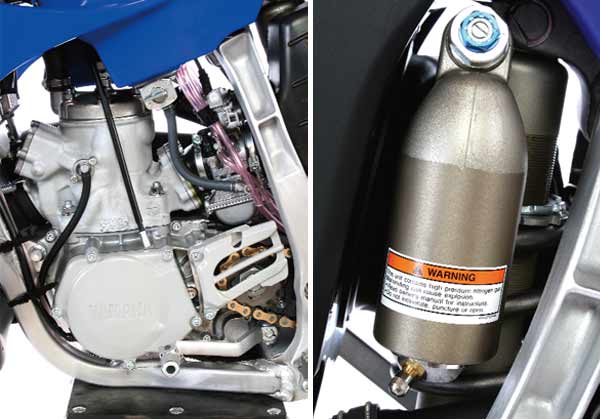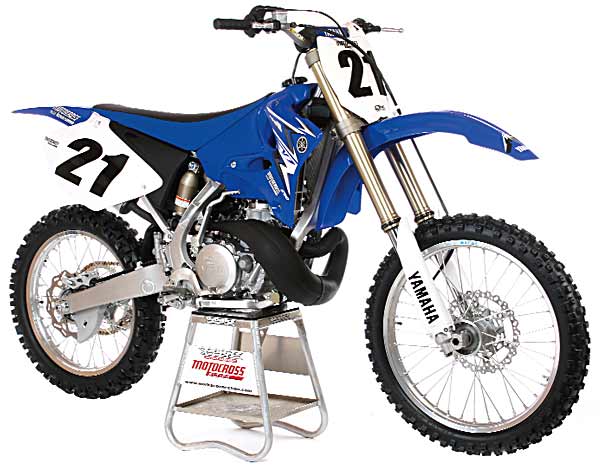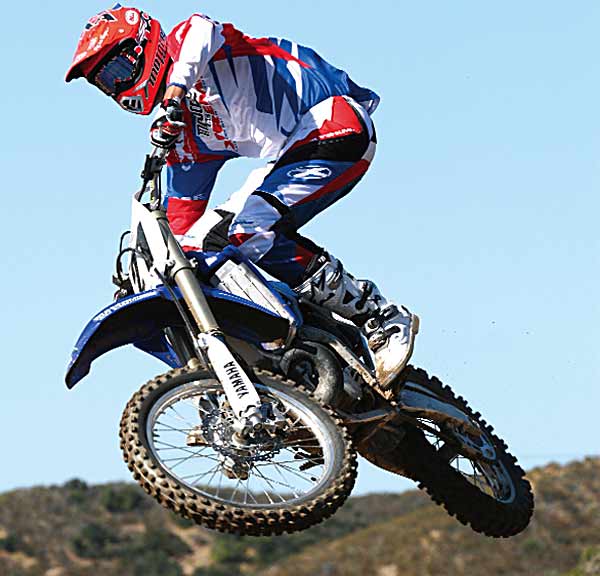2009 Yamaha YZ250 Two-Stroke; Suspension Settings, Jetting Specs, Likes & Dislikes, Plus Much More

How stupid are we? Don’t answer that. Instead, let’s analyze the facts and, if possible, fix the blame on someone other than ourselves. MXA’s first choice is always the AMA when it comes to looking for a scapegoat, followed by the government, manufacturers, marketing men, and if all else fails?the Eskimos.
What’s the problem? The problem is that somehow we went from racing technologically advanced, cheap and easy-to-maintain two-strokes to a world dominated by complicated, heavy, expensive and impossible-to-work-on four-strokes.
In the blame game, the AMA played their part by writing a rules package that allowed oversize four-strokes to compete against undersized two-strokes. If pressed, the AMA will point the finger at the government and claim that the EPA was putting pressure on them to cut emissions (even though the rules do not apply to closed-course motorcycles). Meanwhile, all the major manufacturers signed off on the AMA’s four-stroke exemption rule because they didn’t think that a thumper would ever be competitive against a two-stroke, even if it was twice as large. Of course, the advertising agencies over-sold four-strokes to the masses, and the public, that’s us, lapped it up. Nobody wants to be behind the times, and suddenly two-strokes were old school and four-strokes were cutting edge (and even if that is so far from the truth that it is laughable, no one laughed). Who is really to blame for our four-stroke future? All of us…stupid incorporated. But since we don’t want to take responsibility for this fiasco, we’ve decided to pin the blame on the Eskimos.
The Eskimos may look innocent in all of this, but the sport needs a fall guy who won’t complain.
So here we sit in 2009 with bike prices rocketing skyward, used bike prices plummeting downward, average repair bills that could finance a vacation to Tahiti, and electronic technology that takes all control away from the owner/operator. Are you happy yet?
With only two 250cc two-stroke brands left on the showroom floors (KTM and Yamaha), the MXA wrecking crew took a close look at the 2009 YZ250. Could buying one of these mean you’re smarter than the average guy?
Q: WHAT DO TWO-STROKE SALES HAVE IN COMMON WITH THE STOCK MARKET?
A: They are both going down when they should be going up. Five years ago (2004), two-stroke sales represented 75 percent of new bikes sold. Three years ago (2006), four-strokes and two-strokes reached parity at 50-50. Last year, two-strokes only represented 24 percent of new bike sales. Any bets on what 2009’s percentage will be?
In Yamaha’s case, sales of the YZ85, YZ125 and YZ250 were 50 percent of Yamaha’s sales in 2005. Today, the YZ two-stroke’s share of the pie has shrunk in half (with the YZ125 and YZ250 losing more market share than the YZ85).
Q: WHAT ARE THE BENEFITS OF A TWO-STROKE OVER A FOUR-STROKE?
A: It goes without saying that if displacements were the same, a two-stroke would be ten pounds lighter, ten horsepower more powerful and ten times cheaper to maintain than a four-stroke. But the displacements aren’t the same. Given the unequal nature of the competition, here is where a two-stroke shines.
(1) Price. The retail price of a 2009 Yamaha YZ250 is $800 less than a YZ450F.
(2) Maintenance. When it comes to rebuilding the top-end of a YZ250, all it requires are a piston, rings and gaskets. Rebuilding a YZ450F takes a piston, rings, gaskets, valve seals and a cam chain (plus the potential for valves, valve springs, keepers and valve seats). On the dollar scale, a four-stroke piston costs more than a complete two-stroke rebuild.
(3) Weight. No contest. A YZ125 is 18 pounds lighter than a YZ250F and a YZ250 comes in 12 pounds lighter than a YZ450F.
(4) Power. A YZ250 produces 45 horsepower, while a comparable 250 four-stroke is lucky to make 36 horsepower.
(5) Legal. In many racing organizations, 250cc two-strokes are legal in the 250 four-stroke class.
Q: DID YAMAHA MAKE ANY CHANGES TO THE 2009 YZ250 TWO-STROKE?
A: Yes. Yamaha made five changes (mostly minor).
(1) Front tire. In 2008, the YZ250 came stock with the Dunlop D739 front tire. For 2009, it gets a Dunlop D742FA (the same tire that is spec’ed on the YZ450F).
(2) Rear tire. Although the D756 rear tire looks the same as last year, it is in fact the “G” model tire. How does the 756G differ from a regular 756? It is 200 grams lighter. How much lighter is 200 grams? About seven ounces.
(3) Front brake hose clamp. Yamaha drop-kicked the previous steel front brake hose clamp for a smaller and lighter aluminum clamp. The DR.D-style clamp saves 32 grams (a little more than one ounce).
(4) Chain. The side plates on the new D.I.D. chain have been zinc coated for better rust-resistance.
(5) Seat cover. For 2009, the YZ250 seat cover has a woven pattern instead of the old sandpaper-style gripper material on the seat cover. As a result of these changes, the 2009 YZ250 is one pound lighter than the 2008 model.

Triple trees: The YZ250 didn’t get the adjustable clamps.
Q: ARE THERE ANY OTHER CHANGES ON THE 2009 YZ250?
A: Yamaha had no technical information on any frame changes, but it was obvious to MXA that the gusseting around the head tube had been welded over. Maybe it’s just us, but we concluded this was Yamaha’s solution to the cold weld issues they have had on some aluminum frames.
Q: IS THE 2009 YZ250 ENGINE FASTER THAN THE ’08 ENGINE?
A: Of course not. It is identical to the 2006, 2007 and 2008 engines.
Q: DOES THE YZ250 HAVE THE BEST TWO-STROKE ENGINE IN THE SPORT?
A: Yes. It has the broadest, easiest-to-use and most adaptable powerband of any 250cc two-stroke.
Q: IS THE 2009 YZ250 FASTER THAN A 2009 250 FOUR-STROKE?
A: Yes. In back-to-back testing, the MXA wrecking crew discovered that on average, lap times were identical between a YZ250 two-stroke and YZ250F four-stroke. Logic says that since lap times are virtually identical for the same rider on both bikes, the real difference comes down to the two-stroke’s ten horsepower advantage over the four-stroke’s easier-to-ride package. A racer starting on a typical dirt starting line with a YZ250 two-stroke should always get the holeshot. If the 250cc two-stroke doesn’t beat a 250cc four-stroke to the first turn, the rider needs to work on his technique. The YZ250F four-stroke just can’t overcome the ten horsepower disadvantage in the first 200 feet. From that point on, it’s a matter of whether the track has the kind of conditions that will force the two-stroke rider into making a mistake. If the rider doesn’t falter, he will keep the lead to the checkered flag.

Q: IS THE 2009 YZ250 FASTER THAN THE 2009 450 FOUR-STROKE?
A: No. It gives up a couple of horsepower and several foot-pounds of torque to the big thumper. Additionally, the snappy power of the two-stroke has more of a tendency to lift the front wheel, break traction and spin the rear tire. As a result, the bike turns from the rear. It likes to powerslide and explode out of turns. In soft dirt and loam, the two-stroke gets on top of the dirt much quicker than a four-stroke. It’s more willing to make quick direction changes and switch lines on a whim. YZ250 two-stroke riders are rewarded for seeking out good dirt and taking the bull by the horns. The power delivery of the two-stroke makes it feel lighter.
However, just as with the YZ250 versus YZ250F scenario, where the extra power and torque of the 250 two-stroke make a winning combination, the same power and torque advantage come down on the side of the 450cc four-stroke against a 250cc two-stroke.
Q: WHAT IS THE CHEAPEST WAY TO IMPROVE THE 2009 YZ250 POWERBAND?
A: There are three proven methods.
(1) Gearing. Add one tooth to the rear sprocket. It will punch up the acceleration in second gear and bring third into play sooner. Faster riders, featherweight riders and fast tracks work best with the stock gearing.
(2) Exhaust pipe. Two-strokes love expansion chambers, and the YZ250 is no exception. You can get two extra ponies out of the YZ250 with an aftermarket pipe.
(3) Reed cage. The MXA test riders have raced with both the Moto Tassinari VForce3 and the Boyesen RAD Valve, and the simple truth is that they both work. If you favor stronger midrange, you might go with the VForce3, while the RAD Valve offers the ability to get a potent mid-and-up hit (if you remove the stock 5mm spacer plate). Both reed valves work so well we have to assume that the stocker has some flaws. Boyesen can be reached at (800) 441-1177 and Moto Tassinari’s phone number is (603) 298-6646.
Q: HOW IS THE JETTING?
A: The Yamaha YZ250 is a fully developed machine. Engine R&D was frozen in place in 2006, and all subsequent development has focused on fine tuning the peccadilloes. What does that mean to the average rider? It means that the YZ250 jetting is spot-on. MXA’s recommended jetting is as follows:
Main Jet: 178
Pilot Jet: 50
Needle: N3EW
Clip: Second from top
Air screw: 3/4 turns out (one turn stock)
Notes: The air screw is very sensitive from 1/2 turn to one turn out. In practice, it doesn’t seem to be as critical after one turn out. If you switch to an aftermarket pipe, you might need to go up one on the mainjet.
Q: HOW GOOD ARE YAMAHA’S KAYABA SSS FORKS?
A: Yamaha has the best showroom stock forks. Why are they so great? Because Yamaha’s engineers had an epiphany three years ago and changed their theories on damping. Historically there have been two types of damping: position-sensitive damping and speed-sensitive damping. Almost every other fork is about 70 percent position-sensitive, which means that the damping is dictated by where the fork’s piston is positioned inside the cartridge rod. In simple terms, the farther the piston moves down in the cartridge rod, the stiffer the damping.

Yamaha decided to turn the age-old damping concept on its head by making their SSS forks 90-percent speed-sensitive. With speed-sensitive damping, the damping rate is determined by the speed at which the piston moves though the cartridge rod. In Yamaha’s case, this system works better because when you land hard or hit a bump at high speed, you need the damping to respond to the speed with which the forks are compressing, not to how far into their stroke they have compressed. SSS is a stroke of genius.
Q: WHAT WAS OUR BEST FORK SETTING?
A: For hard core racing, these are MXA’s recommended 2009 Yamaha YZ250 fork settings:
Spring rate: 0.43 kg/mm
Oil height: 130mm
Compression: 13 clicks out
Rebound: 14 clicks out
Fork leg height: 5mm up
Notes: On Yamaha’s SSS forks, there is some crossover between the rebound damping and compression damping, which means that turning the rebound in will make the forks not only slower on rebound, but stiffer in compression.
Q: WHAT ABOUT THE REAR SUSPENSION?
A: The shock on the 2009 YZ250 is about as close as a showroom bike can get to a works shock. Yamaha’s Kayaba shock comes with a jumbo-sized 18mm shock shaft, Kashima-coated internals and a titanium shock spring. Think about that for a second! The 2009 Yamaha YZ250 comes stock with a $600 shock spring that weighs 1-1/2 pounds less than a conventional steel spring. That’s not a bargain, that’s a steal.
We used to recommend stiffer shock springs for riders above 180 pounds, but we think that the 2009 shock works very well for riders up to 200 pounds. For hardcore racing, these are MXA’s recommended 2009 Yamaha YZ250 settings:
Spring rate: 4.9 kg/mm
Race sag: 100mm
Hi-compression: 1-3/4 turns out (1-1/2 stock)
Low-compression: Eight clicks out
Rebound: Eight clicks out
Notes: Yamaha’s high-speed compression clicker (the large dial) is very sensitive to adjustment. Make small (1/8th turn) changes. Use the high-speed adjuster to set the bike’s fore/aft bias at speed. National speed riders and heavyweight contenders will need to move up to a 5.0 kg/mm spring.
Q: HOW DOES THE YZ250 HANDLE?
A: In the rarified air of motorcycle testing, there are bikes that understeer, bikes that oversteer, and bikes that feel like they have a hinge in the middle. Perfection in handling is probably impossible to achieve on a motocross bike, because we ask it to do too many varied tasks during the course of a single lap of a motocross track.
How would we describe the 2009 Yamaha YZ250? It is a stable platform machine. What does that mean? It doesn’t do anything exceptionally well, but it doesn’t do anything poorly either. It is, in the words of most MXA test riders, “neutral.” It is accurate at turn-in, and it requires almost no mid-turn corrections from center-out to exit. It isn’t the sharpest-turning tool in the moto shed, nor does it plow like it’s being pulled by an old Army mule. Its chassis doesn’t impose its will on the bike’s arc at any time. It is putty in the hands of a good rider. It is just enough of everything to make it a complaint-free package.
Q: WHAT ARE THE MUST-HAVE AFTERMARKET PARTS FOR THE 2009 YZ250?
A: We don’t have a lot of wish-list items for the YZ250. To be frank, you can race this bike straight out of the crate with little more than a one tooth larger rear sprocket.
Q: WHAT DID WE HATE?
A: The hate list:
(1) R&D. Since the YZ250 two-stroke has reached the end of its development cycle, it doesn’t get all of the benefits of YZ450F R&D. The list of what it doesn’t get includes the new swingarm, shock linkage, triple clamps, rear hub and clutch lever. It does get the 2009 YZ450F’s seat cover, zinc-coated chain and aluminum front brake hose bracket.
Q: WHAT DID WE LIKE?
A: The like list:
(1) Ti shock spring. Yamaha dropped the expensive titanium shock spring on the YZ250F four-stroke for 2009, but they kept it on the YZ250 two-stroke. Cool.
(2) Frame. We love the look of the aluminum two-stroke frame. Why? Because the hollowed out cavities make the frame look more high-tech than the four-stroke’s smooth tubing. In fact, the hollow cavities are on the inside of the four-stroke frame.
(3) Suspension. We love Yamaha’s SSS suspension. It’s plush, handles chop with ease, and is stiff enough for riders up to 200 pounds.
(4) Rear tire. Yamaha spec’ed a totally new version of the 756 rear tire. The front Dunlop D742 isn’t much to write home about.
(5) Brake hose clamp. The humonguous steel front brake hose clamp has been replaced with an aluminum clamp that is 32 grams lighter.

Q: WHAT DO WE REALLY THINK?
A: Peer pressure is an amazing force. It has the power to make normally rational people buy bikes that are not the best choice for their riding or lifestyle. Let us suggest the 2009 Yamaha YZ250. Why? The YZ250 two-stroke weighs ten pounds less, makes more horsepower per cc, starts on the first kick, can be rebuilt for under $200, has one-tenth the moving parts, never stalls in a corner, can be worked on with a butter knife and retails for almost a thousand dollars less than a four-stroke. Do you need more reasons to buy one?




Comments are closed.